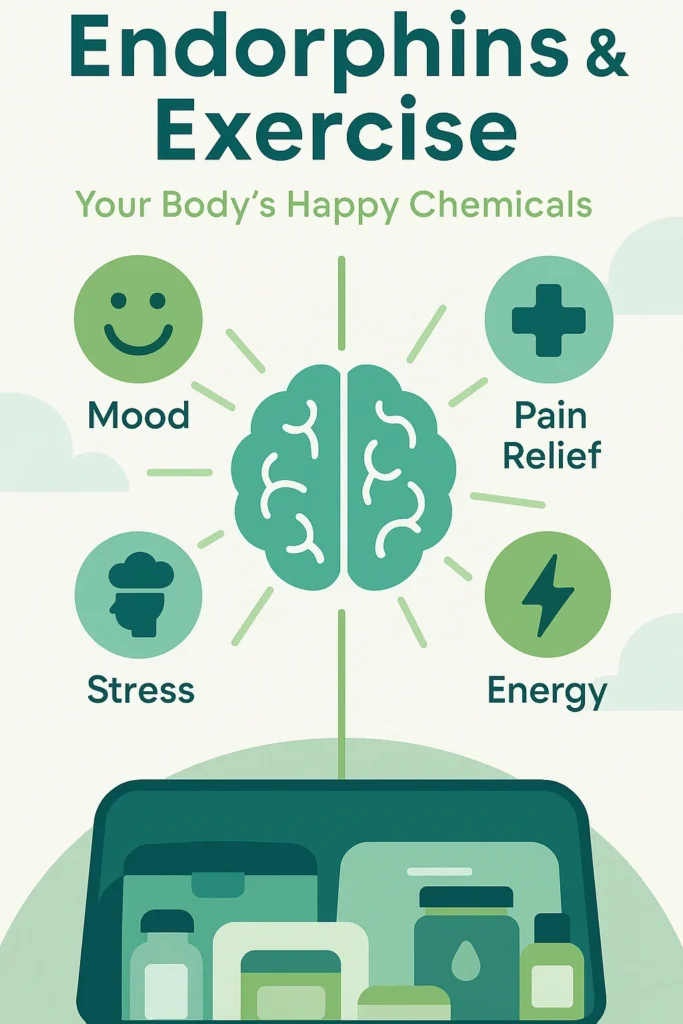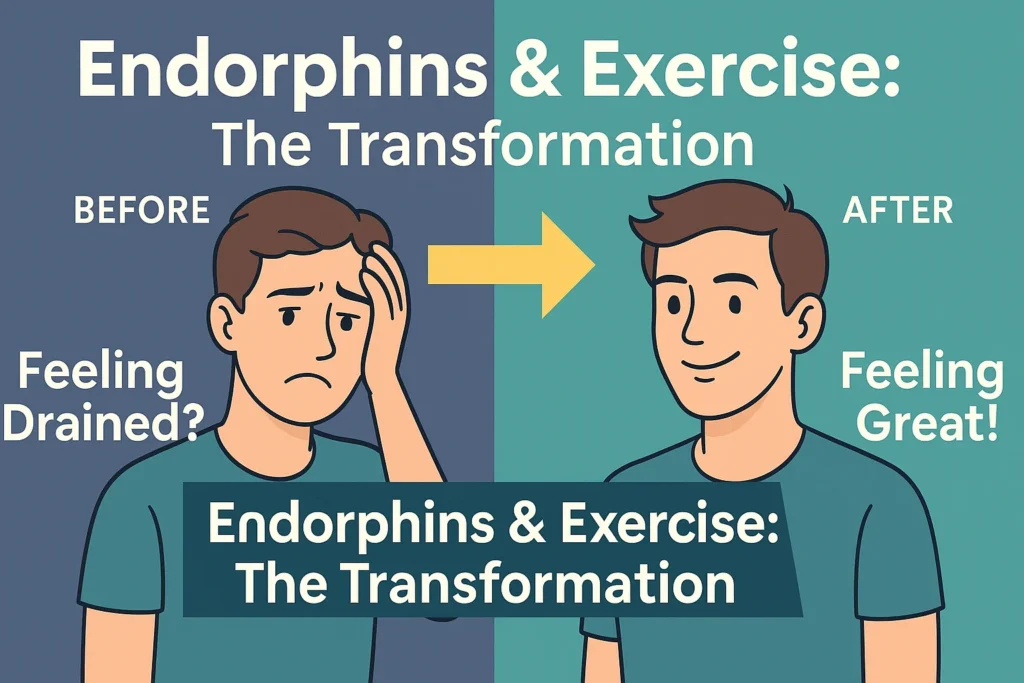Exercise helps your body release endorphins, natural chemicals that can reduce pain and improve your mood.
Endorphins & Exercise — Quick Summary
Quick picks
Top 10 Endorphin‑Boosting Moves
- Zone‑2 cardio (20–30 min): Conversational pace walk/jog/cycle to elevate mood without overtaxing.
- Tempo intervals: 6×(40 s brisk / 80 s easy) or 8×(30/60) on a bike, rower, or track.
- Circuit strength (15–20 min): 2–3 compound lifts (squat, push, pull) at steady tempo; keep rest short.
- Rhythm run: Match steps to 160–170 BPM music to promote flow and reduce rumination.
- Group play: Pick‑up sport or class (boxing, dance, circuits) for social‑boosted euphoria.
- Green minutes: Do it outdoors—sunlight and nature amplify mood effects.
- Finish with strides: 4–6×10–20 s faster efforts with full recovery to spark a feel‑good pop.
- Breath‑paced cooldown: 3–5 min long‑exhale breathing to seal in calm.
- Laugh & loosen: Add 60 s of playful movement (shadowboxing, dance) at the end.
- Consistency: 3–5 sessions/week beats rare all‑out days for sustained mood benefits.
If you have medical conditions, injuries, or are pregnant, consult a health professional before changing your routine.
Estimated reading time: 7 minutes
Ever wonder why you feel so good after a workout? That great feeling often comes from your body’s own natural chemicals. Understanding how endorphins and exercise work together can help you feel better every day. For more tips on staying active, visit our blog.
What Are Endorphins?
Endorphins are like your body’s natural painkillers. Your brain and other parts of your body make them. They connect to special spots in your brain, much like pain relief medicines do. This helps to lessen pain and make you feel happy.

Your body makes different kinds of endorphins. Beta-endorphins are the most powerful type. They are often talked about when we discuss exercise. Endorphins help your body deal with stress and pain. The Mayo Clinic explains more about exercise and stress.
How Exercise Releases Endorphins
Moving your body, especially with activities like running, biking, or swimming, helps release endorphins. This release can make you feel happier and less pain. People often call this feeling a “runner’s high.” The Mayo Clinic explains more about exercise and stress.
How it Works: When you exercise for a while, your body sees it as a small stress. To protect you, your brain sends out beta-endorphins. These go into your blood.
They then connect to pain spots in your brain. This stops pain signals and creates good feelings. Exercise also boosts other brain chemicals like serotonin and dopamine. These also help your mood and thinking. A study in PMC notes these effects.
How Much Exercise? How long and how hard you exercise changes how many endorphins you release. Doing moderate to hard exercise for at least 20 to 30 minutes often raises endorphin levels a lot.
But, very hard exercise might also release stress hormones. This could reduce some of the good mood effects. Research supports this idea.
The “Runner’s High” Debate
Many people think endorphins cause the “runner’s high.” But the full story is more complex. Recent findings from Johns Hopkins University School of Medicine challenge the simple link between endorphins and happy feelings during exercise. Endorphins block pain. However, they may not easily cross into the brain to make you feel happy.
Instead, the good mood and happy feelings you get from exercise might come more from endocannabinoids. These are natural body chemicals. They are like those found in cannabis. They can easily get into the brain. They help lower worry and make you feel calm.
Benefits of Exercise for Your Mind
Exercise helps your mind in many ways, partly due to endorphins and exercise working together.

- Better Mood: Exercise can lower feelings of sadness and worry. Its effects can be similar to some medicines for depression. More serotonin and endorphins together help your mental health. Studies on animals show that light exercise can make brain cells that use serotonin more active. This leads to better moods and less anxious behavior.
- Less Stress: Exercise helps fight your body’s stress response. It releases endorphins and other brain chemicals. This can lower stress signs like a fast heart rate and high blood pressure. This also helps your heart and immune system.
- Clearer Thinking: Being active also makes you think better. It improves focus, problem-solving, and new ideas. Endorphins help create a calm but alert mind. This supports better thinking.
Physical Benefits Beyond Mood
Endorphins do more than just improve your mood. They also make it easier to exercise longer. They do this by changing how you feel pain. Regular exercise also helps your heart, digestion, and immune system. Endorphins help with stress reduction, which supports these benefits.
Physical activity also slows down aging. This is linked to better hormone balance and less swelling in the body. This is partly thanks to the good effects of endorphins and other brain chemicals.
Are You Getting Enough Endorphin-Boosting Exercise?
Best Exercises for Boosting Endorphins
Different types of exercise can help boost your endorphins. If you’re just starting, a beginner’s guide to fitness can help.
- Aerobic Workouts: Running, biking, swimming, and fast walking are best known for releasing endorphins. Steady aerobic workouts often make your mood better. Find out more about home cardio exercises.
- High-Intensity Interval Training (HIIT): This involves short bursts of hard activity with rest in between. HIIT can raise both endorphins and stress hormones. The results depend on your fitness level. Moderate intensity is often better for mood boosts.
- Light, Steady Exercise: Some studies show that light, consistent exercise might be better for boosting serotonin and endorphins. It does this without causing a stress response. This can best reduce worry and sad feelings.
- Be Consistent: Aim for regular workouts, even short ones. Daily movement helps your body adapt.
- Find Your Pace: Moderate intensity often works best. You should be able to talk, but not sing.
- Mix It Up: Try different activities like walking, dancing, or team sports. This keeps it fun and engaging.
- Listen to Your Body: Don’t push too hard. Over-exercising can cause more stress than good.
Facts About Endorphins and Exercise
- A 2017 review of animal studies found big increases in serotonin and endorphins in brain areas linked to mood. This happened after moderate exercise. It showed effects similar to depression medicines.
- About 30-50% of people say they feel a “runner’s high” or similar good feelings during or after long exercise. But many just feel tired or uncomfortable.
- Exercise that raises endorphin levels has been linked to a 20-40% drop in reported worry and sad feelings. This is true for many different groups of people.
Why This Matters for You
Many people in the U.S. face mental health issues and stress. Using exercise to boost endorphins is a key way to help.
Experts suggest at least 150 minutes of moderate exercise each week. This matches guidelines from the CDC. It helps you get the most from endorphins for your mood.
Easy-to-do exercises like walking, tennis, or hiking let many people be active. They can safely enjoy boosting their mood and lowering stress through endorphins.
What We Still Need to Learn
We are still learning about endorphins and exercise.
- We need to know more about how endorphins truly affect mood. This includes how they work in the brain versus the body. We also need to learn more about other brain chemicals like endocannabinoids.
- Everyone’s body reacts differently to exercise. This is due to genes, fitness, and feelings. So, exercise plans might need to be special for each person.
- More large studies on people are needed. These should measure body markers and follow people over time. This will help create clear exercise plans for mental health. These plans would be based on endorphin and brain chemical changes.
Conclusion
Endorphins are a big part of how your body reacts to exercise. They mainly help with pain. With other brain chemicals, they also help your mood and lower stress.
While the idea of endorphins causing all exercise euphoria is changing, their benefits are clear. Using exercise programs that fit you can greatly help your physical and mental health.


